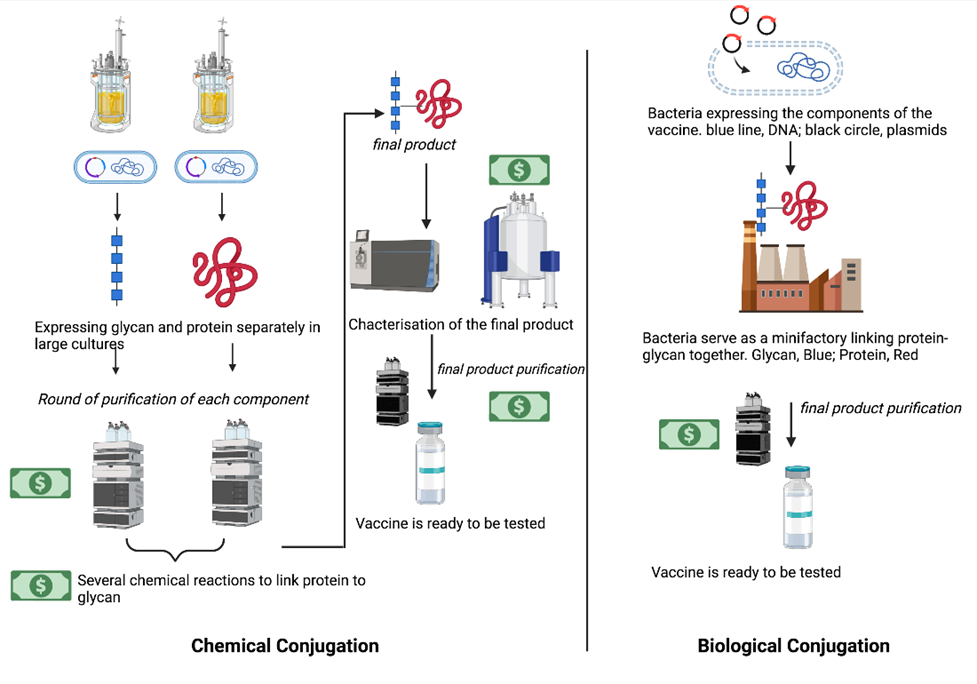In the 1930s a visionary microbiologist, Oswald Avery, reported a new ‘glycoconjugate vaccine’, that could produce a long-lasting immune response contrary to the existing ‘glycovaccine’, which produced a short-living immune response. However, production of this type of vaccine relied on complex chemical reactions.
In this spotlight, Sherif Abouelhadid, Head of Biological and Pharmacological Sciences at the AMR Centre, tells the story of the discovery of an enzyme in Campylobacter jejuni that heralded a new biotechnological era of vaccine development, including against bacterial pathogens.
What is a glycoconjugate vaccine?
Imagine a bacterial cell as a donut with icing sugar. Looking at the donut, you cannot see what is inside the dough because the icing covers the whole donut. This is similar to bacterial cells, but instead of icing sugar, they use other sugars (known as glycans or polysaccharides) that help them evade the immune system surveillance by covering the bacterial cells. Just as every donut comes with different icing sugar, each bacterium has its unique glycan.
In the beginning of the last century, Oswald Avery and colleagues showed that sugar of the encapsulated bacterium determines its antigenic property and the serological relationship of the different strains. This was done via production of one of the world’s first ‘glycovaccines’ by stripping the sugar coat of the bacterial cells and showing a protective effect in laboratory animals. Building on this work, they created a ‘glycoconjugate vaccine’ by linking a protein to the glycan ‘glycoconjugate vaccine’, via complex chemical reactions, which elicited a longer lasting immune response. This strategy has since been used in licensed vaccines against typhoid fever, Streptococcus pneumoniae, and Haemophilus influenzae.
How does a glycoconjugate vaccine work?
Unlike glycovaccines that produce a short lasting immune response, glycoconjugate vaccines have the benefits of eliciting a long-lasting immune response. This means you do not need to get an booster vaccine every five years. Most importantly, this type of vaccine works in children under 5 years old and the elderly – groups that are particularly impacted by AMR infections.
How are glycoconjugate vaccines produced?
For decades, glycoconjugate vaccines were produced using a complex and time-consuming chemical reaction. Until in 2000, when a project led by Professor Brendan Wren and colleagues at LSHTM reported the first whole genome sequencing of the foodborne bacterium Campylobacter jejuni. They discovered an interesting enzyme, which subsequent genetic and biochemical experiments showed catalyses the linking of proteins to glycans. This ushered in a new horizon in biotechnology called ‘Protein-Glycan Coupling Technology (PGCT)’ or bioconjugation. The first ever demonstration of the immense potential of this technology was in 2002. Since then, several candidate vaccines were developed, technology platforms established, and a multimillion pound industry was born.
What is the impact of this type of vaccine or vaccine development on AMR pathogens?
Today, there are at least five start-up companies working to develop vaccines using bioconjugation technology. Targets include at least 10 drug-resistant bacterial pathogens on the WHO priority list, including Klebsiella pneumoniae.
Further improvements of bioconjugation are also being developed at LSHTM, including Sherif's work building computational simulations to develop a glycoconjugate vaccines to combat rise of AMR in Shigella.
If you are interested in learning more about the use of bioconjugation in vaccine development, read our Q&A Dr Jon Cuccui.
Our postgraduate taught courses provide health practitioners, clinicians, policy-makers, scientists and recent graduates with a world-class qualification in public and global health.
If you are coming to LSHTM to study a distance learning programme (PG Cert, PG Dip, MSc or individual modules) starting in 2024, you may be eligible for a 5% discount on your tuition fees.
These fee reduction schemes are available for a limited time only.

